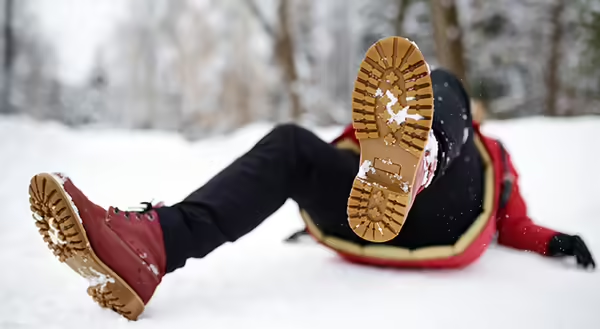
Winter signals the changing of yet another season. As the temperatures drop and snow blankets the landscape, snow and cold weather lovers embrace all that winter has to offer. Whether you love winter or find yourself longing for the warm summer sun, one thing is for certain, we must all pay close attention to our health and the needs of our bodies, especially as we head outdoors.
Slips, trips, and falls can happen any time of year. However, during winter, healthcare facilities see a rise in fall-related injuries, such as fractures, concussions, and sprains. While these injuries are dangerous to everyone, they are especially dangerous to older adults.
Falls are the leading cause of injury among adults 65 years and older and account for 95% of the 300,000 hip fractures in the United States annually.
Fall Risk Factors
Many factors increase our risk of falling, such as reduced muscle strength and overall weakness, poor balance, impaired vision, delayed reaction times, changes in cognition, use of multiple medications, chronic health conditions, poor footwear, and fear of falling. Environmental hazards such as slippery floors, loose rugs, unstable furniture, inadequate lighting, obstructed walkways, pets under food, ice, and snow also increase our risk of falling.
Consuming a healthy, well-balanced diet and intentional exercise will help give your body the nutrients and activity needed to maintain muscle strength. Unfortunately, national nutrition surveys indicate that most people are not getting adequate calcium needed to grow and maintain healthy bones, putting them at increased risk for osteoporosis and fractures.
In addition to being aware of fall risks, you must be intentional about consuming foods rich in calcium and vitamin D. You can get vitamin D from sunlight, your diet, and a dietary supplement. Since the cold weather often keeps people indoors over the winter months, including foods fortified with vitamin D and taking nutritional supplements are great ways to help keep your bones strong. Natural sources of vitamin D are limited. However, salmon, herring, sardines, canned tuna, cod liver oil, egg yolks, and mushrooms are excellent natural sources.
Calcium is not only crucial for your bones. It is also needed for your heart, muscles, and nerves to function properly and for blood to clot. Not getting adequate amounts of calcium increases your risk of developing osteoporosis and low bone mass and increases the risk of fractures. The recommended daily calcium intake is 1,000 mg per day for most adults, though women over 50 and everyone over 70 should get 1,200 mg per day, and children aged 4–18 should consume 1,300 mg. Dairy products, such as milk, cheese, and yogurt, are rich in calcium. However, other excellent sources include seafood, leafy greens, legumes, dried fruit, tofu, and foods fortified with calcium.
Steps to Prevent Falls
Consume a balanced diet. A balanced and varied diet will help your body get the nutrients needed to maintain health. Being intentional about including foods rich in calcium and vitamin D is a cornerstone of good bone health. However, you may need to include dietary supplements to ensure you are getting adequate amounts of calcium and vitamin D.
Limit sodium intake. High sodium intake increases calcium excretion through the kidneys, putting you at risk for bone loss. If you already struggle to get adequate amounts of calcium in your diet, limiting the amount of sodium in your diet will help preserve the calcium you are consuming.
Slow down. Take small, slow steps if you walk on icy or slick services. Watch for ice on steps and walkways, and use caution when getting in and out of vehicles.
Fall-proof your house. Be proactive and remove items you could trip over, install extra lighting throughout, and install grab bars in the bathroom. Consider adding contrasting color strips to stairs, allowing you to visualize stairs better. Wet floors can be slippery and dangerous, so wipe up any water or snow as soon as possible. If your home has rugs throughout, select rubber-backed or non-skid mats to prevent trip hazards.
Clear walkways. Remove snow and ice from walkways. Adding sand or salt will improve traction on slippery surfaces.
Wear proper footwear. Whether indoors or out, wearing proper footwear is a must. Wear footwear that fits properly and provides ankle support and adequate traction.
I hope your wellness journey is going smoothly and you enjoy this winter season. As we enter this holiday season, you still need to be intentional on this journey. You cannot simply throw caution to the wind because it's the holidays. Remember how far you have come and that you do not want to lose any progress.
References
- Hip Fractures Among Older Adults. Centers for Disease Control and Prevention
- Facts About Falls. Centers for Disease Control and Prevention
- Top Foods for Calcium and Vitamin D. WebMD
- Food and Your Bones — Osteoporosis Nutrition Guidelines. The Bone Health & Osteoporosis Foundation
- Preventing Falls at Home Room by Room. National Institute on Aging
SOURCE: Diane Reinhold, MPH, MS, RDN, Nutrition and Wellness Educator, University of Illinois Extension serving Jo Daviess, Stephenson, and Winnebago Counties.
Want to read more? Check out Walking the Line: A Journey of Wellness. A wellness blog intended to raise awareness, inspire behavior change, share new skills, and validate that life is truly challenging. However, as we grow and learn together, I hope each of us will look within ourselves and acknowledge our own personal choices and behaviors and how they contribute to our overall state of health and wellness. Please join me in this amazing adventure as we journey together, walking the line toward health and wellness.